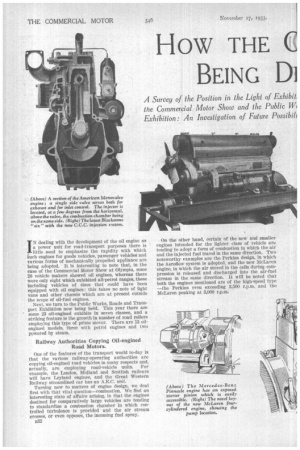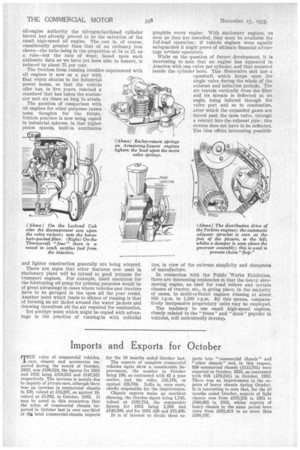How THE C
Page 46

Page 47

Page 48

If you've noticed an error in this article please click here to report it so we can fix it.
IL ENGINE IS
BEING Di
VELOPED
A Survey of the Position in the Light of Exhibit. the Commercial Motor Show and the Public IV( Exhibition: An Investigation of Future Possibill IN dealing with the development of the oil engine as a power unit for road-transport purposes there is little need to emphasize the rapidity with which such engines for goods vehicles, passenger vehicles and various forms of mechanically propelled appliance are being adopted. It is interesting to note that, in the case of the Commercial Motor Show at Olympia, some 26 vehicle makers showed oil engines, whereas there were only eight which exhibited all-petrol ranges, these including vehicles of Sizes that could have been equipped with oil engines ; this takes no note of light vans and other chassis which are at present outside the scope of oil-fuel engines.
Next, we turn to the Public Works, Roads and Transport Exhibition now being held. This year there are some 23 oil-engined exhibits in seven classes, and a striking feature is the growth in number of road rollers employing this type of prime mover. There are 13 oilengined models, three with petrol engines and two powered by steam.
Railway Authorities Copying Oil-engined Road Motors.
One of the features of the transport world to-day is that the various railway-operating authorities are copying oil-engined road vehicles in many respects and, actually, are employing road-vehicle units. For example, the London, Midland and Scottish railcars will have Leyland engines, and the Great Western Railway streamlined ear has an A.E.C. unit.
Turning now to matters of engine design, we deal first with that vital question—combustion. We find an interesting state of affairs arising, in that the engines destined for comparatively large vehicles are tending to standardize a combustion chamber in which controlled turbulence is provided and the air stream crosses, or even opposes, the incoming fuel spray.
B32
Oil the other hand, certain of the new and smaller engines intended for the lighter class of vehicle are tending to adopt a form of combustion in which the air and the injected fuel travel in the same direction. Two noteworthy examples are the Perkins design, in which the Aerofiow system is adopted, and the new McLaren engine, in which the air stored in the cells during compression is released and discharged into the air-fuel stream in the same direction. • It will be noted that both the engines mentioned are of the high-speed type —the Perkins even exceeding 3,500 r.p.tn. and the McLaren peaking at 3,000 r,p.m. One of the new examples which directly opposes the foregoing principle, but is typical of general practice obtaining in large units, is the Armstrong-Saurer. The fuel is injected at an angle towards the base of the air cell, in which occurs primary combustion, and the ,air from the cylinder crosses the fuel path almost at right-angles, entering through the main throat and three smaller passages nearer the tip of the atomizer.
• Owing to the more widespread use of definitely controlled turbulence, it is not now necessary to indulge in very high injection pressures. This is an important advantage hi that it cuts out many of the difficulties connected with fuel-pump manufacture and maintenance. It also is a great help in that it is not necessary to employ such tiny holes in the atomizers. Where it is possible to use a single-hole sprayer, or one with three holes, each of, say, more than eight-thousandths of an inch diameter, the manufacturing process is less tricky and the upkeep less difficult than the employment of five holes of five-thousandths of an inch .diameter, or eyen less.
While on the question of combustion processes, it is interesting to note that the modern oil engine, as used in vehicles, is capable of giving a performance in the way of fuel consumption in the order of .4 lb. per b.h.p.hour at full load. This result has been attained in less than five years, and is only improved upon by much larger engines which have been evolved in the course of 30 years.
• An analogous matter is 'that of performance. On the whole, piston speeds have increased by some 20 per cent, in the past three years, and the b.m.e.p. by 10 per cent. One of the main points which is often ignored is that the b.m.e.p. has improved, not only at full load, but at partial loads, which account for some 85 per cent, of the working life crf a vehicle engine.
Weight Reduced to 10.1 lb. per b.h.p. in the A.E.C. Unit.
Bound up with the question of performance is that of weight. One of the most striking instances at the Commercial Motor Show was the A.E.C. Q-type oil engine which, with a bore and stroke of 105 mm. and 146 mm. respectively, gives an output of 125 b.h.p. and weighs, complete with electric starter and dynamo, 10.1 lb. per b.h.p. Without the starter and dynamo the figure is 8.8 lb.
On the subject of wear, the centre of discussion is usually that of the cylinder barrel. In the view of one B33 oil-engine .authority the nitrogen-hardened cylinder barrel has already proved to be the salvation of the small high-speed oil engine. The cost is, of course, considerably greater than that of an ordinary iron sleeve—the ratio being in the proportion of 54 to 22, as • a rule—but the rate of wear, based upon such authentic data as we have yet been able to inspect, is reduced by about 75 per cent.
The freedom from running troubles experienced with oil engines is now on a par with that which obtains in the industrial power house, so that the vehicle oiler has, in five years, reached a standard that has taken the stationary unit six times as long to. attain.
The question of comparison with oil engines for other purposes raises some thoughts for the future. Vehicle practice is now being copied in industrial spheres, in that higher piston speeds, built-1n auxiliaries and lighter construction generally are being adopted.
There are .signs that other features now used in stationary plant will be turned to good purpose for transport engines. For example, hand operation for the lubricating oil pump for priming purposes would be of great advantage in cases where vehicles and tractors have to be garaged in the open all the year round. Another point which tends to silence of running is that of forming an air jacket around the water jackets and drawing therefrom all the air required for combustion.
Yet another point which might be copied with advantage is the practice of running-in with colloidal graphite every engine. With stationary engines, so soon as they are installed, they must be available for full-load operation ; if vehicle engines were equally safeguarded it might prove of ultimate financial advais tage to-their operators.
While on the question of future development, it is interesting to note that an engine has appeared in America with one valve per cylinder, and that mounted beside the cylinder bore. This Monovalve unit has a camshaft which keeps open the single valve during the whole of the exhaust and induction periods: The air travels vertically from the filter and its stream is deflected at an angle, being Induced through the valve port and so to combustion, after which the expanded gases, are forced past the open valve, through a venturi into the exhaust pipe ; this stream does not have to be deflected. The idea offers interesting pefssibili ties, in view of the extreme simplicity and cheapness of manufacture.
In connection with the Public Works Exhibition, there are interesting tendencies in that the heavy slowmoving engine, as used for road rollers and certain classes of tractor, etc., is giving place, in the majority of cases, to multi-cylinder engines running at about 800 r.p.m. to 1,200 r.p.m. By this gleans, comparatively inexpensive proprietary units may be employed.
The tendency to use small high-speed engines, closely related to the " fours " and "sixes" popular in vehicles, will undoubtedly develop.




























































































